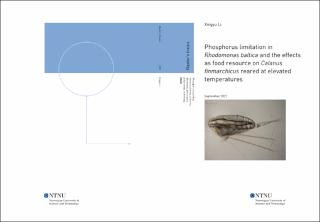| dc.description.abstract | Elevation in water temperature due to the climate change is considered one of the major factors to influence the microalgae and zooplankton community. The copepod genus Calanus is ecologically important as an energy bridge connecting lower to higher trophic level. However, physiological activities of Calanus may be affected due to the climate change. Increased water temperature also causes eutrophication which stimulates excessive growth of algae with variable nutritional quality. This, in turn, may influence Calanus as it grazes upon microalgae. The aim of this study was therefore to investigate the effect of increased temperature along with decreased food quality on Calanus with respect to phosphorus. The North Atlantic species Calanus finmarchicus was reared at two elevated temperature regimes, 12°C and 14°C and fed phosphorous-limited microalgal phytoplankton Rhodmonas baltica. Phosphorus limitation on microalgae was induced by reducing NaH2PO4 of the original Conwy medium (100%) to 50% and 12.5 %. Cellular carbon, nitrogen, phosphorus analysis of microalgae showed that the P level in algal cells decreased with decreasing medium P level, while carbon and nitrogen content were lowest with moderate P limitation. Fatty acid composition in the algae showed significant differences where strong P limitation reduced the eicosapentaenoic acid (EPA) and docosahexaenoic acid (DHA) content. Adult C. finmarchicus reared at 14°C were generally smaller in prosomal volume than those at 12°C. Neither temperature nor food quality significantly affected lipid storage of copepods. Fatty acid composition of C. finmarchicus was analyzed. Major differences were found in the long chain fatty acids 22:1n-11, which were generally more abundant at 14°C, while the level of EPA and DHA were higher at 12°C. Food quality did not seem to have a clear effect on the fatty acid composition. Egg production rate of copepods was reduced at 14°C which is likely due to the lower content of the essential fatty acids EPA and DHA which are needed for egg production. Hatching success of copepod eggs in the present study was affected by temperature but not food quality. Egg size did however increase with increasing temperature. Surprisingly, egg size was negatively correlated to the egg production rate in the present study. Overall, temperature seems to have a strong effect on C. finmarchicus rather than food quality, and no additive effect was observed in this study.
KEY WORDS: Calanus finamrchicus; Rhodomonas baltica; Temperature; Phosphorus limitation; Reproduction; Lipid; Fatty acids | |
